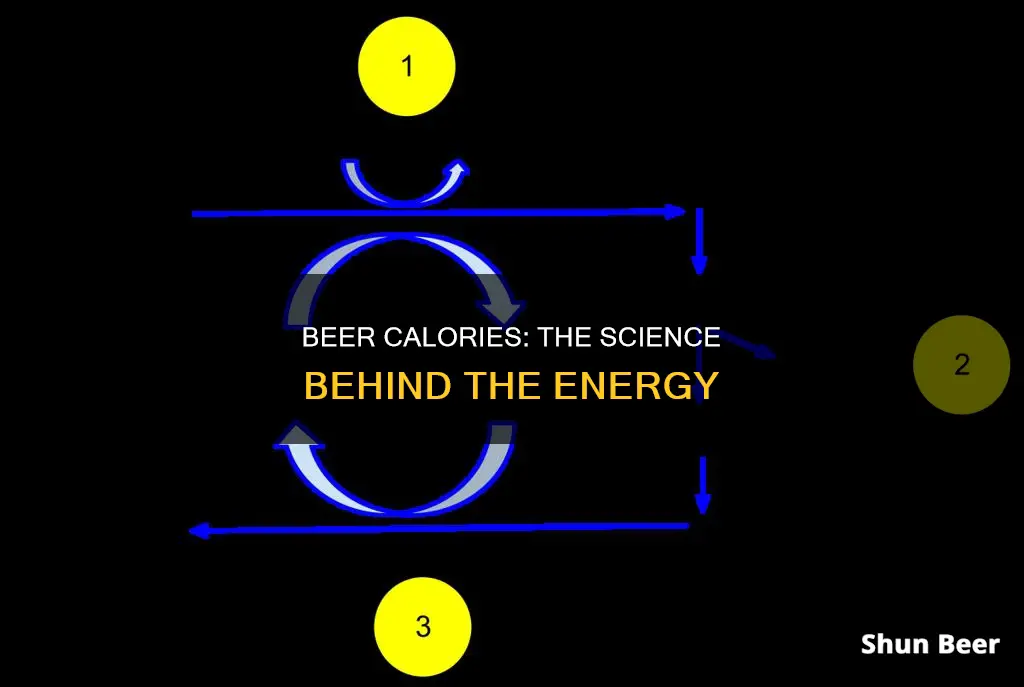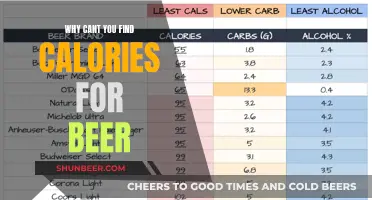
Beer is a popular drink worldwide, but many people wonder what gives it its calories. Beer is made from fermented grain, and its calories mainly come from carbohydrates and alcohol. The amount of calories in beer varies depending on its ingredients and alcohol content. A higher alcohol content generally means more calories, and added sugars also increase the calorie count. Beer is often compared unfavourably to other alcoholic drinks in terms of calories, but in reality, it has fewer calories than drinks like absinthe, sambuca, and gin.
What You'll Learn

Alcohol and carbs are the main sources of calories in beer
Alcohol and carbohydrates are the main sources of calories in beer. Beer is made from fermented grain, and the calories come mostly from the alcohol and the residual carbohydrates that are left over after the fermentation process.
Fermentation breaks down the simple carbohydrates, but the longer chains of carbs that remain after fermentation contribute to the overall calorie count. Generally, around 60% of the calories in beer come from alcohol, and the remaining 40% come from carbohydrates. For example, a typical 12-ounce beer contains about 14 grams of ethanol and 11 grams of carbohydrates, which equates to 98 calories from ethanol and 44 calories from carbohydrates, for a total of 142 calories.
The calorie content of beer varies depending on the ingredients and alcohol content. Beers with higher alcohol levels tend to have more calories, and beers with added sugar also have extra calories. A classic beer with an average alcohol content of around 5% has about 43 calories per 100ml. A higher-alcohol beer, like Sam Adams Boston Lager (4.9% alcohol), has about 175 calories per 12-ounce bottle.
Compared to other alcoholic drinks, beer is one of the lowest-calorie options. For example, a regular beer has 43 calories per 100ml, while absinthe has 348 calories per 100ml. However, heavy beer consumption can contribute to weight gain, so it's important to drink in moderation.
Yueng Beer's Calorie Count: How Does It Compare?
You may want to see also

Beer has no fat content
Beer is made from fermented grain, typically barley, wheat, or rye. The brewing process involves malting, mashing, boiling, fermenting, and bottling. The type of grains, brewing times, and flavorings used determine the different brew styles.
While beer has no fat content, it can still contribute to weight gain, including belly fat. This is because it is high in calories, and drinking alcohol can increase appetite and prevent the body from burning fat. Additionally, the customs associated with beer drinking, such as consuming salty and greasy bar foods, can also contribute to weight gain.
It is important to note that moderate consumption of beer, limited to one drink per day, may not significantly affect weight. However, regular binge drinking or consuming more than one beer per day can increase the risk of belly fat gain and other health problems.
Zero-Calorie Beer: Enjoy Guilt-Free Sipping
You may want to see also

Beer calories depend on alcohol content and ingredients
Craft beers, seasonal beers, and beers with high alcohol content tend to have more calories than lighter beers. Beer colour is not a useful indicator of calories, meaning darker beers do not equate to high-calorie beverages. Low-calorie beers are often light in colour and thin in body because they use fewer grains, replacing them with adjuncts to reduce the number of residual carbohydrates while keeping the alcohol level.
The most effective methods for making lower-calorie beer are reducing alcohol content, reducing residual carbohydrates, or a combination of both. Beer is believed to have originated in the Middle East almost 5,000 years ago and was first commercially produced in Germany, Austria, and England in the 13th century. Today, it is a popular drink worldwide and an essential part of the food and beverage industry.
Low-Calorie Beer: 64-Calorie Brews for the Health-Conscious Drinker
You may want to see also

Beer is not the drink with the most calories
Beer is often associated with a higher number of calories compared to other alcoholic drinks. However, it is important to note that beer is not the drink with the most calories. While a standard glass of wine can contain up to 158 calories, and a pint of stronger lager can have up to 222 calories, there are other drinks that surpass these numbers.
The calorie content of beer varies depending on factors such as alcohol content and type. Craft, seasonal, and high-alcohol beers tend to have more calories than lighter options. Non-alcoholic beers, on the other hand, typically contain fewer calories.
When considering the drink with the most calories, one must look beyond just alcoholic beverages. Some non-alcoholic drinks can also be calorie-dense. For example, a large (20 oz) Starbucks Peppermint White Chocolate Mocha contains 680 calories, while a large (32 oz) Dunkin' Donuts Frozen Mocha Coffee Coolatta has 990 calories. These drinks are loaded with added sugars and fats, contributing to their high-calorie content.
Additionally, certain cocktails and mixed drinks can be significantly higher in calories than beer. For instance, a Long Island Iced Tea, which combines multiple types of liquor with cola and sour mix, can contain up to 780 calories per glass. Similarly, a White Russian, made with cream, vodka, and coffee liqueur, can pack up to 500 calories.
In conclusion, while beer can be calorie-dense, it is not the drink with the most calories. There are several alcoholic and non-alcoholic beverages that surpass the calorie content of beer. It is important to remember that moderation is key when it comes to maintaining a balanced diet and a healthy lifestyle.
Calorie Count for Stone & Wood Beer Revealed
You may want to see also

Beer is not the main cause of a beer belly
Beer bellies, or potbellies, are a common phenomenon, especially among older men. But is beer really to blame for this type of weight gain and abdominal obesity?
Despite the name, beer is not specifically responsible for the beer belly. Research from the Czech Republic, a country known for its beer culture, found no link between beer consumption and an increase in girth. In a study of nearly 2,000 adults, beer drinkers did not have larger waistlines than non-drinkers.
So, if it's not beer, what is to blame for the beer belly? The main culprit is excess calorie consumption. Beer does contain calories, with a standard 12-ounce beer providing about 150 calories, and light beer around 110 calories. However, it is important to note that any excess calories, whether from alcohol, sugary drinks, or oversized portions of food, can contribute to weight gain and belly fat.
Additionally, alcohol interferes with the body's ability to burn fat. When you consume alcohol, your liver prioritises burning off the alcohol instead of fat. This interference with fat burning can contribute to weight gain and abdominal obesity.
While beer is not the sole cause of a beer belly, it can certainly contribute to it. The high calorie content of beer, combined with its ability to stimulate appetite and impair judgment, leading to unhealthy food choices, can result in excess calorie consumption and subsequent weight gain. Therefore, drinking in moderation and opting for lower-calorie or non-alcoholic options can help reduce the risk of developing a beer belly.
Calories in Cobra Zero Beer: A Healthy Option?
You may want to see also
Frequently asked questions
The main sources of calories in beer are carbohydrates and alcohol.
Beer is one of the alcoholic drinks with the least calories. Some drinks with higher calorie counts include absinthe, sambuca, baileys, pastis, amaretto, and gin.
Beers with stronger alcohol levels and added sugar have more calories. The colour of the beer does not determine its calorie content.







